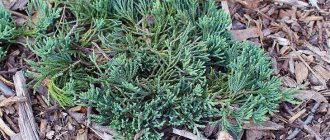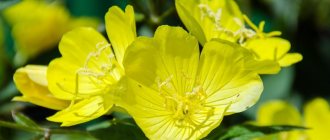Decorating a garden with gooseberries is a very correct decision, which will require the gardener to know the basics of choosing the right seedlings, selecting a planting site, fertilizing, watering, propagating and pruning. Knowledge of the rules for combating diseases and pests will help keep the plant healthy and the harvest consistently tasty.
Gooseberries are often called “northern grapes”. Gardeners love it for its high yield, unpretentiousness and pleasant dessert taste.
And the comparison with grapes is not accidental. Gooseberries not only contain a huge amount of vitamins, but they also make wine no worse than grape wine!
Gooseberries are a traditional berry crop, without which it is difficult to imagine a garden plot. Its fruits are superior to many others in terms of the amount of ascorbic acid. It contains a large amount of sugars, organic acids, calcium, phosphorus and iron.
Gooseberries begin to bear fruit quite quickly and are capable of producing up to 30 kg of berries from one bush. With good care, it can bear fruit for more than 15 years. The berries are very diverse in taste, size and color from emerald green to purple-black. They ripen 1.5-2 months after the start of flowering.
When and where to plant?
Gooseberries bear fruit well in almost any soil. The only things he doesn’t like are waterlogged, heavily podzolized, too sour and cold. Flooding of the site with spring waters is also unacceptable. Gooseberry roots are located shallow in the soil and, when overwatered, quickly begin to rot. Therefore, it is better to place bushes in elevated places, protected from cold winds.
Gooseberries can be planted in the spring, before buds open, or in the fall. For planting, we select free areas, preferably not occupied by fruit trees. When shaded, the bushes are severely affected by powdery mildew, reducing the yield and quality of berries.
We plant young seedlings at a distance of 1-1.5 m from each other in a row and 2 meters between rows. I do not recommend planting several gooseberry seedlings in one hole. So it quickly thickens and ages, and caring for the thorny thickets becomes impossible.
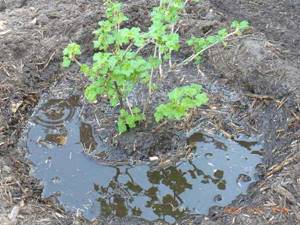
We prepare the soil for planting gooseberries in the same way as for currants, only we dig a deeper hole. When planting, add 8-10 kg of humus or compost, as well as a good dose of phosphorus and potassium fertilizers (up to 100 g of active ingredient per 1 sq. m). We use a mixture of phosphate rock or bone meal with superphosphate as a phosphate fertilizer, and wood ash as a potassium fertilizer. We thoroughly mix all the fertilizers with the soil removed from the hole and fill it with this mixture. Such fertilizing will provide the growing gooseberry with nutrients for the first 3-4 years.
We plant the gooseberries somewhat deeper than they grew in the nursery, and at an angle (for better formation of additional roots and new basal shoots). To ensure good survival and branching, we cut off the above-ground part of the bush after planting, leaving 3-4 buds on the shoot.
November
Provide protection from rodents
Before the end of the season, take care of young gooseberry plants; in the event of severe frosts before a stable snow cover falls, their roots may be damaged. Sprinkle the soil around the planted bushes with an additional layer of mulch, use dry leaves and spruce branches.
Start setting up snow retention shields. In flat areas, dig furrows across the slope to prevent spring meltwater from melting and washing away fertile soil.
Before heavy snowfalls, consider rodent protection measures. Place poisoned baits in mouse holes. You can use folk remedies, but it is more convenient to use chemical preparations against mice, water voles and other rodents. Use them strictly according to the instructions and follow safety precautions. Place bait directly into holes or into bait boxes or tubes. It is important to prevent birds and pets from being harmed by toxic substances.
How to care?
The main task in the first years after planting is to ensure rapid rooting of seedlings and create conditions for active growth. Therefore, we keep the soil around the bushes moist and loose and regularly free it from weeds. To retain moisture in early spring, be sure to mulch the soil after loosening. You can mulch with compost, which in the fall, when digging, is simply buried in the soil.
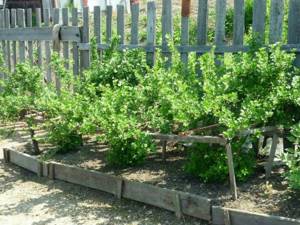
To improve the illumination and ventilation of the bush, we lift the branches hanging to the ground on supports in the summer, and remove them from them in the fall. This way we create conditions for the retention and accumulation of snow. Gooseberries are less winter-hardy than currants and need more protection in winter. In harsh winters with little snow, gooseberry roots may freeze. Plants need help to survive the cold without loss! Therefore, as soon as the snow falls, we carefully shovel it under the bushes - the more, the better! Covered with a fluffy blanket of snow, the bush will overwinter well and in the spring will produce many new root shoots. Gooseberry flowers and ovaries, as a rule, do not suffer from frost.
January
Rake snow from paths and distribute under bushes
In winter, the orchard is dormant and sleeps under a blanket of snow, but there is always work for an experienced gardener. The main concerns are related to snow retention; this is especially true in light-snowy, “black” winters, when thaws can give way to sharp cold snaps.
Reliable protection of the roots from frost is provided by a layer of snow 12-15 cm high. If there is not enough snow under the bushes, rake it off the paths and distribute it in the area where the roots are located. You can cover the bushes with snow, but do not expose the roots. This measure will protect the shoots from severe frosts.
When and what to feed?
In the spring and summer (from bud break to the end of shoot growth), gooseberry bushes need feeding. The need for nitrogen is especially great at this time. In the second half of summer and until late autumn, plants need more phosphorus and potassium.
Good results are obtained by fertilizing with solutions of bird droppings, mullein, slurry or mineral fertilizers. To prepare mineral fertilizer, take 30-50 g of ammonium nitrate, 50-80 g of superphosphate and 20-30 g of potassium salt in a bucket of water. We feed the plants once during the formation of the ovary.

August
Treat gooseberry bushes against diseases and pests
After complete harvesting, be sure to inspect the gooseberry bushes and find out how affected they are by diseases and pests. Depending on the degree of damage, treat with chemical or biological preparations, you can use herbal infusions. Remove weak, dried out, diseased shoots.
Continue to care for rooting horizontal layering and green cuttings. Feed them a second time, hill up and water the cuttings.
Destroy weeds on which pests can settle, and water the bushes in dry weather.
When and how to water?
Although gooseberries are quite resistant to temporary drought, high yields of large berries are possible only on sufficiently moist soil. We do the first watering of gooseberries after flowering - during the period of increased shoot growth and ovary formation. The second - during the ripening period of the berries, and the third - after harvesting, for the formation of future flower buds.
In a dry autumn, abundant moisture-replenishing watering is necessary to enhance root growth and improve the overwintering conditions of plants. To ensure proper watering around the bush, we dig a ditch running approximately along the perimeter of its crown. We supply 30 liters of water into it for each bush. When the water is absorbed, we level the groove. After watering and loosening the soil around the bushes, we mulch each time.
June
Weed and water gooseberry bushes
Weed around the bushes and mulch the soil to retain moisture.
Water when hot and dry weather occurs. You need to water not in small portions, but spending 20-30 liters of water per bush.
At the beginning of the month, combine watering with fertilizing with complex mineral fertilizers, available organic or organomineral mixtures.
Take care of the rooting horizontal layers of gooseberries, hill them up or mulch them with loose material, water them if necessary and feed them with nitrogen fertilizer. Before fertilizing, be sure to water the soil, then cover it with soil.
How to prune?
We prune gooseberry bushes in order to give the plants the correct shape. In addition, proper pruning will protect the bush from thickening and will contribute to a bountiful harvest. You may be surprised, but even a newly purchased bush, consisting of only 3-4 branches, should be pruned! On each of them you need to leave 2-4 buds, and the rest can be safely removed. Don’t worry, next year the bush will grow rapidly and, perhaps, will already produce its first harvest!
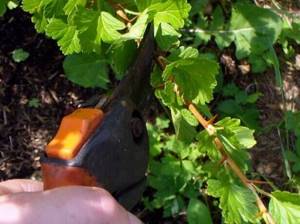
In the spring of next year, as soon as branches from the roots begin to grow from the ground, we leave 3-4 of them and remove the rest. We choose only powerful, well-developed shoots. Their tops will need to be cut off so that side branches appear. However, for varieties with a high degree of branching, this procedure does not need to be done: everything will work out by itself. Remember that the degree of shortening of the shoots should correspond to the degree of their development. The basic rule: the more branching, the more moderate the pruning.
If you stick a branch into the drainage hole of the pot in the spring, then by autumn you will have a new plant
Do you want your gooseberries to be larger? Then in the summer, do additional pruning of green shoots, leaving no more than six leaves and one berry in each tassel. This simple technique allows you to obtain gooseberry fruits of a much larger size than usual.
Features of planting gooseberries in the regions
Gooseberries are grown in different climatic zones, and the technique for planting them is, in principle, the same. This is a fairly unpretentious shrub that grows in various conditions. However, in the case of extreme climates, there are still some nuances.
Planting gooseberries in Siberia
In Siberia, gooseberries are considered a cover crop. In winter, over most of Siberia, both annual growth and roots located close to the surface of the earth often freeze. In this regard, at the end of autumn, the bushes must be carefully bent for the winter, pinning the branches to the soil with any suitable material, so that in the end they are securely covered with snow. As a rule, bushes that are overfed with fertilizers or heavily thickened ripen poorly. Consequently, a feature of planting gooseberries in this area is maintaining a slightly larger distance between plants. In Siberia, gooseberries begin to be planted a little earlier than usual - from the beginning of September.
Planting gooseberries in Ukraine
It should be recalled that Ukraine is the second largest country in Europe, and the climate in its different regions varies quite a lot. For example, the optimal time for planting gooseberries in the center and north of Ukraine is at the beginning of October. A bush planted at the right time takes root well, quickly begins to grow in the spring, grows steadily, develops and produces its first harvest on time. In the south of Ukraine, where the climate is much milder, gooseberries are planted later - from mid-October until the end of November.
Planting gooseberries in Belarus
In Belarus, gooseberries are grown in every garden, and this is a long-standing tradition: after all, one of the best large-fruited ancient varieties is even called Belarusian. Since the climate in this republic is practically no different from that in the central regions of Russia, the planting technology does not differ in anything specific. Belarusians often practice spring planting, but they do it very early - even in March, as soon as the weather permits.
Belarusian gardeners advise planting black or red elderberry next to the gooseberries, and regularly scattering its branches under the gooseberry bushes in the summer.
Planting gooseberries in the Moscow region
It is best to plant gooseberries in gardens near Moscow in the fall. In the Moscow region, the organization of the sale of planting material is now well organized. Therefore, you can often purchase a seedling with a closed root system, that is, in a container. In this case, gooseberries can be planted with a whole earthen lump even in summer.
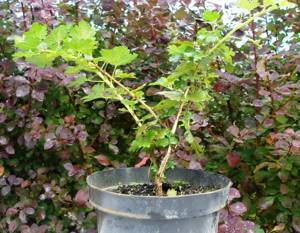
A seedling with a closed root system can be planted even in summer
When planting several gooseberry bushes, maintain a distance of up to 2 m between them: in the conditions of the Moscow region, very large bushes often grow.
The peculiarities of the climate near Moscow are sufficient rainfall and the absence of sweltering heat, so plants quickly increase their green mass. Planting pits in the Moscow region are prepared with a diameter and depth of 0.5–0.6 m. In addition to the top layer of soil, 10–12 kg of manure or a mixture of peat and manure (4:1 by volume) is placed in the pit. Any organic fertilizer is used, but usually in a mixture with peat, a shortage of which is not observed in the region. Peat significantly improves soil aeration, optimally structuring it.
How to reproduce?
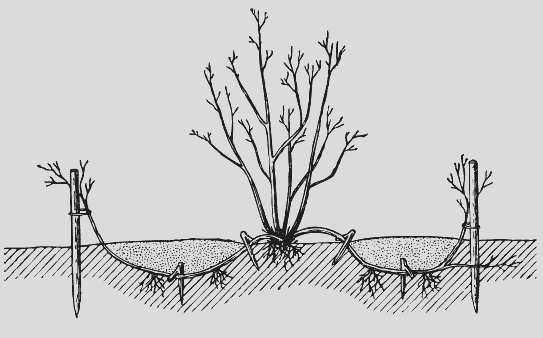
Gooseberries are propagated by bush layering, as well as lignified or green cuttings. It is best to do this in early spring, before sap flows and buds begin to bloom. I'll tell you how I do horizontal layers. In my garden there is a wonderful old gooseberry variety called Black Negus. Many of my guests ask me to share this plant with them. That's why I propagate it periodically!
I make a cut on one or several branches close to the ground. I bend the branch to the ground, dig a shallow hole, and lower the branch into it. Then I fill the hole with soil and water it. I keep the soil moist all summer. By autumn, roots form in the section of the branch. In the spring of next year, I separate the rooted seedling from the mother bush. The new plant is ready to plant!
We cut cuttings from root shoots or annual growths of fruiting branches. Each cutting 20 cm long should have at least 4-5 buds.
To root gooseberry cuttings, we prepare a “school”. We dig trenches up to 30 cm deep in open ground and fill them with coarse river sand. A greenhouse can also be used for a nursery.

Before planting, pre-soak the cuttings in water or a solution of a root formation stimulator for a day. Then we plant it in the nursery obliquely, according to a 5x10 cm pattern, so that one bud remains on the surface.
After planting and watering, mulch the soil with a small layer of humus (up to 5 cm thick). During the growing season (until the end of August), we periodically feed the seedlings with solutions of mineral fertilizers: 40 g of ammonium nitrate per bucket of water, 20 g each of superphosphate and potassium salt (sylvinite, kainite).
Gooseberries can produce adventitious roots from below, at the base of the branches. Therefore, bushes can be propagated by division.
In the fall, we dig the bush out of the ground and divide it into parts that have their own roots and shoots. At the same time, we remove the old branches and shorten the young ones.
The best varieties
In the process of fruitful work, breeders managed to obtain more than one and a half thousand varieties of this crop. Summer residents have the opportunity to plant any modern thornless gooseberry variety in the Moscow region in spring or autumn. Due to the absence of thorns, the subsequent harvesting process is greatly simplified. Next, we will talk in more detail about the types of gooseberries that are adapted for planting and growing in this region.

The peculiarities of the local climate are long, harsh winters and a small number of very warm and sunny days. Therefore, each variety is necessarily endowed with such qualities as winter hardiness and a developed root system. Let's talk about which thornless and large-fruited varieties are best to plant in your region in spring or autumn.
Sirius
Berries of this variety have a sweet taste with some sourness. They grow in tassels. You can eat them fresh or use them to prepare preserves.
Grushenka
The gooseberry variety has single and almost invisible thorns. The berries are naturally endowed with a beautiful dark purple color and look somewhat reminiscent of a pear in shape. They grow in clusters of several pieces. This type has a high content of healthy pectins and has excellent taste.
Northern captain
An excellent variety of gooseberry, from which, among other things, they make delicious wine. This type of favorite berry cannot boast of a great taste, but is indispensable for wine production. Externally, the berries are almost black in color and have a shiny waxy coating on the surface.
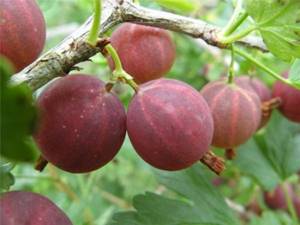
They are located in a brush of 3 pieces. Northern captain has advantages such as resistance to fungal diseases and a high degree of productivity.
Ural thornless
The fruits of this gooseberry variety have a characteristic sweetish taste with a piquant sourness. The bushes are tall and powerful. The advantages include stable immunity to major diseases, in particular powdery mildew.
Russian yellow
A representative of the large-fruited species of your favorite berries. The fruits are located on medium-sized bushes with medium-sized and thin thorns. Each fruit is painted in a beautiful burgundy color, weighs about 6 grams and has a sweet, tart taste with some sourness.
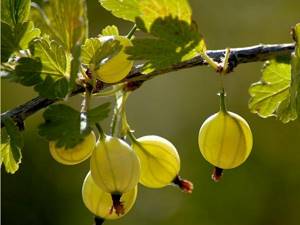
This type of crop requires the formation of a bush. It does not require special care, the shrubs can be planted both in spring and autumn, and also consistently produce a rich harvest.
Belarusian sugar
Another large-fruited gooseberry variety. It is convenient for planting on a personal plot of any size, since it is quite compact and squat. It has an early fruiting period and good frost resistance. The berries are usually colored a pleasant green color, weigh about 9 grams each and have a pleasant sweet taste. The Belarusian Sugar has good immunity to infections and does not require complex care.
Invicta
An excellent development by English breeders is the result of crossing 3 varieties - a species called Invicta. It is somewhat similar to Russian Yellow. Only ripe berries have a yellow-green skin. The leaves are colored light green.

The bush is quite spreading and vigorous with a large number of shoots. The fruits can be called medium in size. Their ripening period is mid-July.
Kolobok
This interestingly named shrub is tall and grows very quickly. On the shoots you can see thin and small thorns. The berries are traditionally colored in a noble dark brown color, have a round shape and weigh up to 8 grams each.

The advantages of this type include high immunity and the possibility of obtaining a good harvest from each bush. When carrying out maintenance in order to increase the degree of productivity, regular pruning is required.
Hinomaki
These are shrubs of an unusual round shape. Their numerous shoots are quite thin and have thorns.
The tasty berries ripen in early July. They have a rich red color and a round shape. The pulp is endowed with pleasant sweetness and sourness. The advantages of this type include resistance to infections (such as powdery mildew), winter hardiness and the ability of the fruit to remain on the bush for a long time.
Rolanda
A gift to our compatriots from German breeding specialists. Such shrubs are medium in size and have fairly long shoots. They ripen oval, dark red fruits with a matte surface, each weighing about 5 grams. When consumed, the berries give everyone their unforgettable sweet and sour taste and aroma. This gooseberry variety has a consistently high yield.
Neslukhovsky
The result of the work of Ukrainian breeders. It is a vigorous and slightly spreading shrub with straight shoots, which can be planted on your site in spring or autumn.
From it it is possible to collect round-oval fruits with a fairly strong skin of medium thickness. They have an exquisite dessert taste. The advantages of this species include its high frost resistance, good immunity, productivity, and the ability of the berries to remain on the bushes for a long time.







